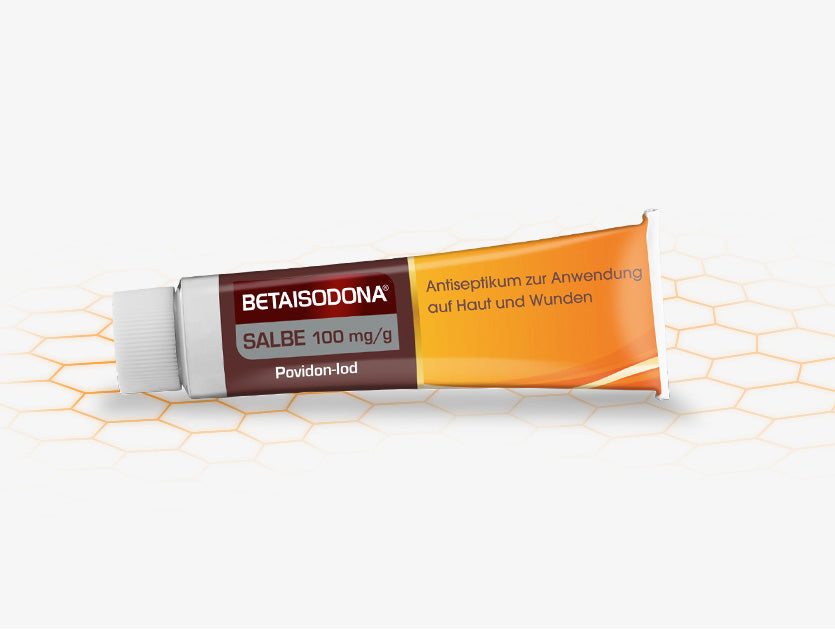- Sku: 03930478
- Vendor: MUNDIPHARMA GmbH
BETAISODONA ointment - suitable for the initial treatment of superficial wounds and minor burns.
order safely & quickly
Fast & reliable shipping with DHL
BETAISODONA ointment
PZN: 01952547
MUNDIPHARMA GmbH
Active ingredients
- 100 mg povidone iod
Excipients
- Macrogol 400
- Macrogol 1000
- Macrogol 1500
- Macrogol 4000
- Sodium bicarbonate
- Water, purified
Indication/Application
- The preparation is a germicidal agent (antiseptic) for use on skin and wounds.
- The ointment is used repeatedly for a limited period of time as an antiseptic for damaged skin, such as: B. Bedsores (pressure ulcers), leg ulcers (leg ulcers), superficial wounds and burns, infected and superinfected skin diseases.
dosage
- Always use the ointment exactly as directed. Please ask your doctor or pharmacist if you are not sure.
- Unless otherwise prescribed by the doctor, the ointment is usually used as follows:
- Apply the ointment evenly to the damaged area one or more times a day.
- If necessary, a bandage can then be applied.
- The brown color of Betaisodona ointment is a property of the preparation and indicates its effectiveness. Increasing discoloration indicates a decrease in the effectiveness of the preparation. If the color is completely discolored, it is no longer effective. If you notice extensive discoloration of the ointment, you should reapply the ointment.
- duration of use
- The application should be continued as long as there are still signs of inflammation. If your symptoms have not improved after using the ointment regularly for several days (2 to 5 days), or if symptoms recur after treatment has been completed, please consult your doctor.
- If you have used more than you should
- Please read the "Side Effects" category.
way
- The ointment is intended exclusively for external use.
Side effects
- Like all medicines, the preparation can have side effects, although not everyone gets them.
- The following frequency information is used as a basis for evaluating side effects:
- Very common: more than 1 in 10 people treated
- Common: less than 1 in 10, but more than 1 in 100 people treated
- Uncommon: less than 1 in 100, but more than 1 in 1,000 people treated
- Rare: less than 1 in 1,000, but more than 1 in 10,000 people treated
- Very rare: less than 1 in 10,000 people treated, or unknown
- possible side effects
- Immune system diseases/skin diseases
- Rarely
- Hypersensitivity reactions of the skin, e.g. late-type contact allergic reactions, which can manifest themselves in the form of itching, redness, blisters, burning, etc.
- Very rare
- Acute general allergic reactions, possibly with a drop in blood pressure and/or shortness of breath (anaphylactic reactions); Acute swelling of the skin or mucous membranes (angioedema or Quincke's edema).
- Rarely
- endocrine diseases
- Significant iodine absorption can occur with long-term use of the preparation on extensive areas of skin, wounds or burns.
- Very rare
- Hyperthyroidism (iodine-induced hyperthyroidism), possibly with symptoms such as increased pulse rate or inner restlessness in patients with thyroid diseases.
- Metabolic and nutritional disorders/diseases of the kidneys and urinary tract
- Rarely
- After using large amounts of medicines containing povidone-iodine (e.g. in burn treatment): electrolyte and serum osmolarity disorders, impairment of kidney function, hyperacidity of the blood (metabolic acidosis).
- Rarely
- Immune system diseases/skin diseases
- If you get any side effects, talk to your doctor or pharmacist. This also applies to side effects that are not specified.
interactions
- When using the preparation with other medicines
- Please inform your doctor or pharmacist if you are taking or have recently taken any other medicines, even if they are non-prescription medicines.
- Povidone-iodine can react with protein and various other organic substances such as blood and pus components, which can reduce its effectiveness.
- When the preparation and enzymatic wound treatment agents are used at the same time, the enzyme component is oxidized by the iodine, thereby weakening the effect of both drugs.
- A mutual weakening of the effect also occurs when the drug is used simultaneously with hydrogen peroxide, taurolidine and silver-containing disinfectants or silver-containing wound dressings (formation of silver iodide).
- The preparation must not be used simultaneously or shortly afterwards with disinfectants containing mercury, as iodine and mercury may form a substance that damages the skin.
- Do not use the medicine at the same time as or immediately after using disinfectants containing the active ingredient octenidine on the same or neighboring areas, otherwise temporary dark discoloration may occur there.
- If you are being treated with lithium preparations, you should avoid long-term and/or large-scale use of the preparation, as ingested iodine can promote the triggering of hypothyroidism, which may be caused by lithium.
- For information on discoloration of materials, see the Patient Information category.
- Influencing diagnostic examinations or radio-iodine therapy
- Because of the oxidizing effect of the active ingredient povidone-iodine, various diagnostic tests can produce false-positive results during treatment with the drug (including toluidine and guaiac resin for determining hemoglobin or glucose in stool or urine).
- Povidone-iodine can influence the iodine uptake of the thyroid; This can lead to disruptions in diagnostic examinations of the thyroid (thyroid scintigraphy, PBI determination, radio-iodine diagnostics) during treatment with the preparation and make planned radio-iodine therapy impossible. Before a new scintigram is taken, an interval of at least 1 - 2 weeks should be maintained after discontinuation of treatment with the drug.
- When using the medicine with food and drinks
- Not applicable.
Contraindications
- The medicine must not be used:
- if you have an overactive thyroid (hyperthyroidism) or another existing (manifest) thyroid disease,
- in the very rare chronic skin inflammation dermatitis herpetiformis Duhring,
- during and until the completion of radiation therapy with iodine (radio-iodine therapy) or if such treatment is planned for you,
- if you are hypersensitive (allergic) to the active ingredient or any of the other ingredients.
pregnancy and breast feeding period
- Before using any medicines, ask your doctor or pharmacist for advice.
- During pregnancy and breastfeeding, the medicine should only be used on the express instructions of the doctor and in an extremely limited manner. In this case, a check of the child's thyroid function is necessary.
- Ingestion of the ointment by the infant through the mouth through contact with the treated part of the breastfeeding mother's body must be avoided.
Patient information
- Particular care is required when using it
- If you suffer from thyroid disease or have a goiter, you should only use the solution over a long period of time and over a large area if your doctor has expressly instructed you to do so (e.g. over 10% of the body surface and for longer than 14 days).
- Even after therapy has ended (up to 3 months), attention should be paid to early symptoms of possible hyperthyroidism and thyroid function should be monitored if necessary.
- Elderly people
- Since older people more often suffer from thyroid dysfunction, large-scale and long-term use of the solution should only be carried out in older people (>/= 65 years) after the doctor's express instructions.
- If necessary, thyroid function should be monitored.
- newborns and infants
- For newborns and infants up to 6 months of age, the solution should only be used on the express instructions of the doctor and in an extremely limited manner. A check of thyroid function is necessary.
- Ingestion of the solution by the infant while breastfeeding must be avoided.
- Notice
- The ointment is grease-free and washable. It can generally be removed from textiles and other materials with warm water and soap. In stubborn cases, ammonia (spirit ammonia) or fixing salt (sodium thiosulfate) can help. Both are available in pharmacies or drugstores.
- Driving and using machines
- The ointment has no influence on the ability to drive and use machines.

BETAISODONA ointment - suitable for the initial treatment of superficial wounds and minor burns.
E-Rezept auf der Krankenkassenkarte? Apo-Versand App!
Jetzt kostenlos runterladen!
.png)
★★★★★ 5 / 5 (Sehr Gut)






